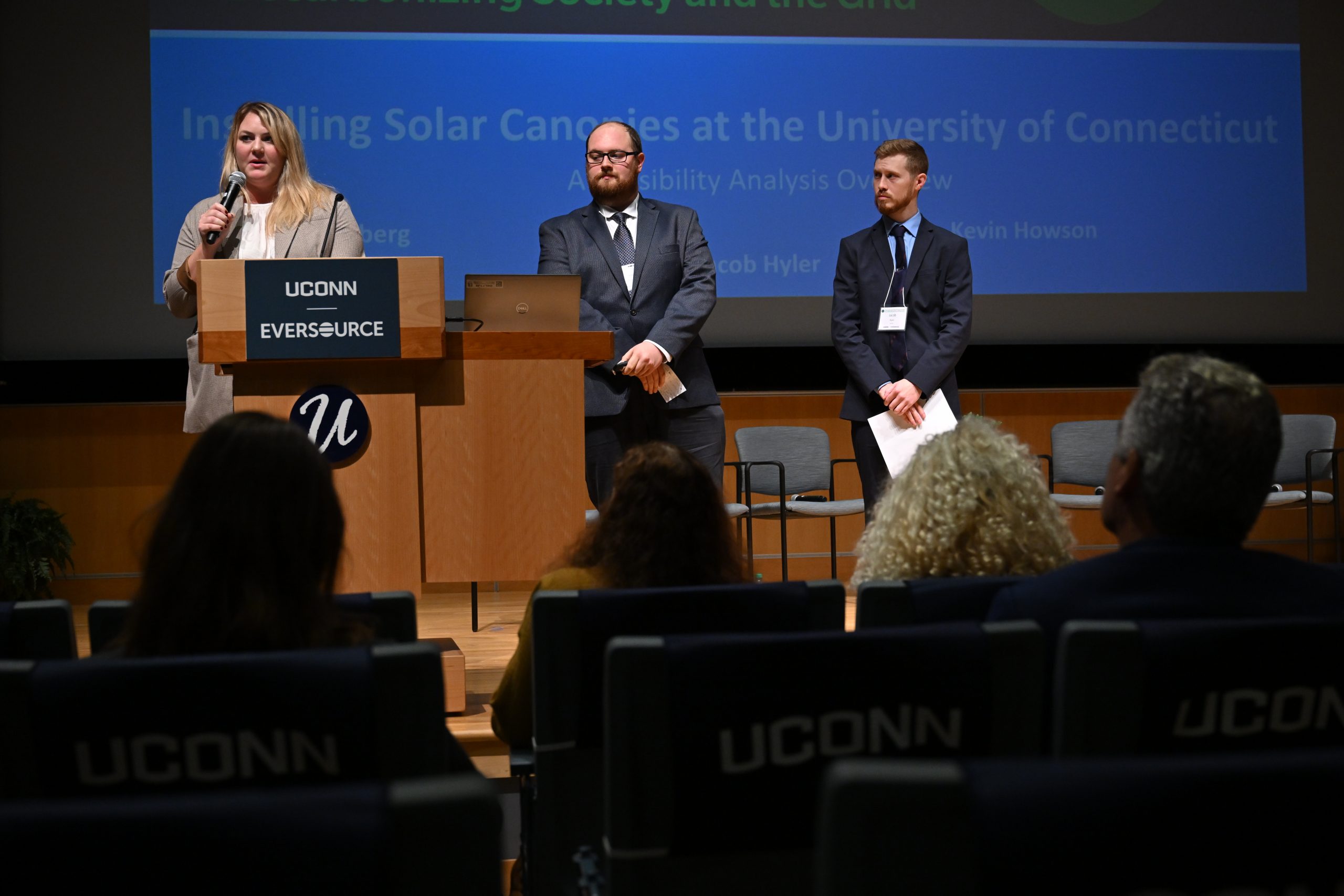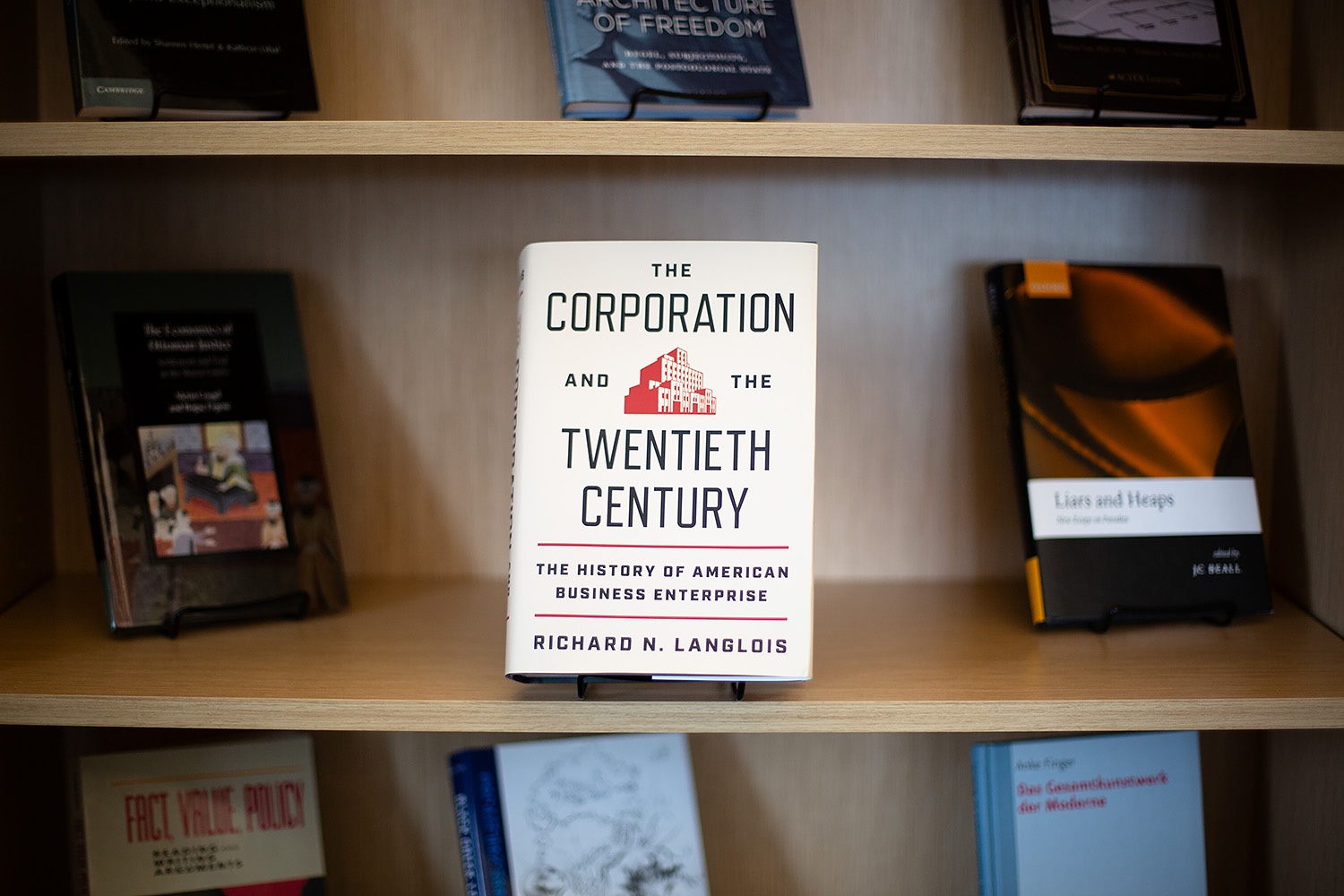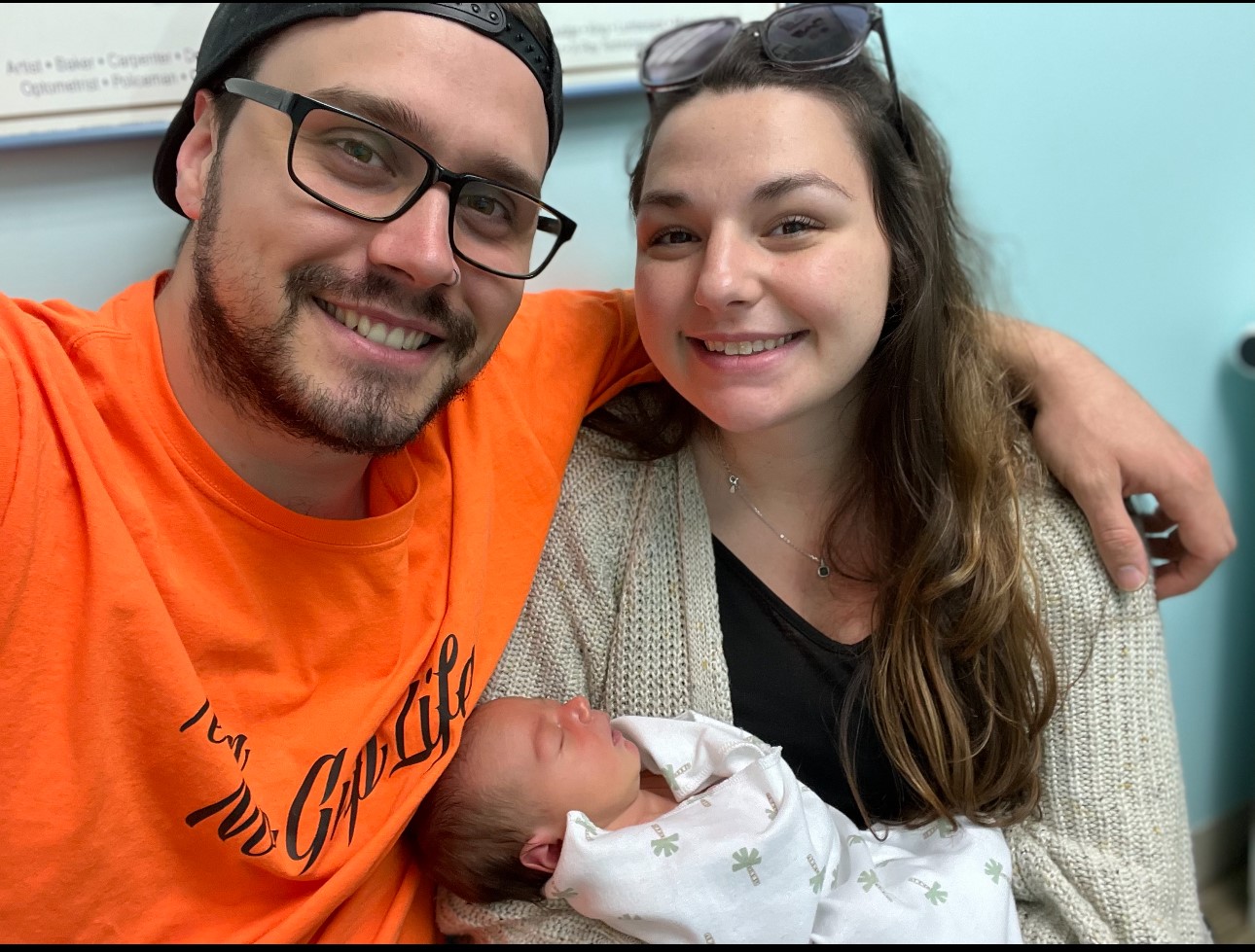The School of Engineering honored six outstanding individuals with special recognitions during the annual banquet and awards ceremony April 17th. Five of the honorees were named to the School’s Academy of Distinguished Engineers and one was presented the 2007 Distinguished Engineering Service Award. The event, which also included the award of merit scholarships to outstanding students, took place before an audience of over 600 alumni, corporate friends, faculty, and scholarship awardees and their parents. University of Connecticut President Philip E. Austin, along with Interim Dean Erling Smith, welcomed guests and presented opening remarks. University Provost Peter Nicholls and Dean Smith then introduced the Academy of Distinguished Engineers inductees and service award recipient.
The 2007 inductees include Ronald D. Goldblatt, Julie A. Pollitt, John R. Rhode, Jr., Sudhakar V. Shenoy and Jack E. Stephens. The Distinguished Engineering Service Award was presented to professor emeritus Mahmoud Melehy of Electrical & Computer Engineering. Short profiles for all of the award recipients appear below.
For profiles of previous Academy inductees since 2003, visit www.engr.uconn.edu/alumni/on the School of Engineering website.
During the evening the School awarded more than $550,000 in academic merit scholarships to 217 continuing students and offered another $800,000 to entering engineering students. The scholarships are funded by donations from generous corporate friends and alumni.
 Ronald D. Goldblatt (M.S., Ph.D., Materials Science, ’84, ’87) is an IBM Distinguished Engineer and Senior Manager of Advanced Silicon Science and Process Technology at the T.J. Watson Research Center, Yorktown Heights, NY. He joined IBM in 1981 and has held technical positions of increasing responsibility culminating in his appointment to the executive position of Distinguished Engineer in 2005. Dr. Goldblatt has made outstanding contributions to silicon processes and engineering and is a leader in semiconductor materials research. He was instrumental in IBM’s transition to copper metallurgy in semiconductor processing in the mid 90’s. As the technical leader and – later – technical manager, he was responsible for initial feasibility, proof of concept, scale-up into development, and technology transfer to manufacturing. He holds key patents in this area. The transition to copper afforded IBM a 15% performance increase and a clear leadership position lasting several years.
Ronald D. Goldblatt (M.S., Ph.D., Materials Science, ’84, ’87) is an IBM Distinguished Engineer and Senior Manager of Advanced Silicon Science and Process Technology at the T.J. Watson Research Center, Yorktown Heights, NY. He joined IBM in 1981 and has held technical positions of increasing responsibility culminating in his appointment to the executive position of Distinguished Engineer in 2005. Dr. Goldblatt has made outstanding contributions to silicon processes and engineering and is a leader in semiconductor materials research. He was instrumental in IBM’s transition to copper metallurgy in semiconductor processing in the mid 90’s. As the technical leader and – later – technical manager, he was responsible for initial feasibility, proof of concept, scale-up into development, and technology transfer to manufacturing. He holds key patents in this area. The transition to copper afforded IBM a 15% performance increase and a clear leadership position lasting several years.
Since 2002, Dr. Goldblatt has led a joint research-development team that creates prototypes for many of the breakthrough technology concepts originating in IBM Research and has enabled implementation of these processes in the 300mm manufacturing line in IBM’s semiconductor fabrication facility. He is currently leading his team in expanded new directions, exploring the ultimate capabilities of silicon based devices as well as novel post-CMOS concepts.
 Julie A. Pollitt (B.S. Mechanical Engineering, ’88) is a Program Analyst in the Office of Program Analysis & Evaluations, Office of the Administrator at the National Aeronautics & Space Administration (NASA), Washington, DC. Her duties include development of an agency-level performance management system; negotiation of externally tracked performance metrics with the Office of Management and Budget; and product development and reporting on NASA programs and projects for the White House’s Budget and Performance Integration Initiative. Since joining NASA Headquarters in 2002, she also has served as Deputy Program Manager of NASA’s largest aeronautics research program, and as a Strategic Analyst.
Julie A. Pollitt (B.S. Mechanical Engineering, ’88) is a Program Analyst in the Office of Program Analysis & Evaluations, Office of the Administrator at the National Aeronautics & Space Administration (NASA), Washington, DC. Her duties include development of an agency-level performance management system; negotiation of externally tracked performance metrics with the Office of Management and Budget; and product development and reporting on NASA programs and projects for the White House’s Budget and Performance Integration Initiative. Since joining NASA Headquarters in 2002, she also has served as Deputy Program Manager of NASA’s largest aeronautics research program, and as a Strategic Analyst.
Ms. Pollitt began her career as a Design Engineer with the NASA-Ames Research Center’s Mechanical Systems & Controls unit, Moffett Field, CA in 1988. She held various positions of responsibility, including Mars Airplane Conceptual Design Team Co-Lead; Business Development Manager; and Intelligent, Digitized Shuttle Application Lead. As a Congressional Science & Technology Fellow assigned to Rep. Tony Hall (3rd District – OH), she was responsible for legislation affecting the U.S. Air Force and related to access-to-space/reusable launch vehicles, aging aircraft and the insufficient investment in defense aerospace science and technology. Ms. Pollitt has received numerous NASA honors, including the Special Achievement and Spotlight Awards. She earned her M.S. at Stanford University (1991).
 John R. Rhode, Jr. (B.S. Electrical Engineering, ’60) is the Founder and Managing Director of Sound Consulting Associates LLC, which caters to service and manufacturing clients in the development and implementation of strategic plans, performance improvement and breakthrough management projects. Earlier in his career, as Director of Strategic Planning for Engelhard Corporation (1991-95), Mr. Rhode helped the company quadruple its stock price and led a key Engelhard re-engineering team whose successes were cited in Michael Hammer’s book, The Reengineering Revolution.
John R. Rhode, Jr. (B.S. Electrical Engineering, ’60) is the Founder and Managing Director of Sound Consulting Associates LLC, which caters to service and manufacturing clients in the development and implementation of strategic plans, performance improvement and breakthrough management projects. Earlier in his career, as Director of Strategic Planning for Engelhard Corporation (1991-95), Mr. Rhode helped the company quadruple its stock price and led a key Engelhard re-engineering team whose successes were cited in Michael Hammer’s book, The Reengineering Revolution.
Prior to joining Engelhard, Mr. Rhode was a Senior Consultant, Director of Planning, and Vice President of Marketing and Planning for the Industrial Products Group of Combustion Engineering; Vice President of Marketing and Planning for the Power and Industrial Sector; and CEO of a Combustion Engineering subsidiary. He previously served as Vice President of LPL Technology’s Amphenol subsidiary, and Chief Engineer for the command and data links on the APOLLO Project for MIT’s Instrumentation Lab, where he was responsible for the command and data transmissions to and from the spacecraft and also participated in the preflight training of the astronauts. Mr. Rhode was a member of the Board of Directors of The Strategic Planning Institute. He earned his M.S.E. in Computer Applications from MIT and an MBA from Harvard University.
 Sudhakar V. Shenoy (M.S. Electrical Engineering, ’71; MBA ’73) is founder (1981), Chairman and CEO of Information Management Consultants, Inc. (IMC), which received the Golden Hammer Award, presented by the Vice President of the U.S., and the Government Computer News Industry Information Technology Award. Earlier in his career, Mr. Shenoy was a Senior Business Analyst with American Management Systems (’78-’80), held technical positions with Windsor Manufacturing (’73-’78) and was an adjunct faculty member in the UConn School of Business (’72-’74).
Sudhakar V. Shenoy (M.S. Electrical Engineering, ’71; MBA ’73) is founder (1981), Chairman and CEO of Information Management Consultants, Inc. (IMC), which received the Golden Hammer Award, presented by the Vice President of the U.S., and the Government Computer News Industry Information Technology Award. Earlier in his career, Mr. Shenoy was a Senior Business Analyst with American Management Systems (’78-’80), held technical positions with Windsor Manufacturing (’73-’78) and was an adjunct faculty member in the UConn School of Business (’72-’74).
Mr. Shenoy represented the U.S. in a Presidential trade and development mission to India (’95) and on trade missions to Spain and Berlin. He was named among the Top 25 Most Influential People in the Washington, DC high-tech industry; the 2004 Small Contractor Executive of the Year by the Northern Virginia GovCon Council, the Professional Services Council and Washington Technology; and the Washington Area Minority and Small Business Person of the Year (1995). He received the Greater Washington High Technology Entrepreneur of the Year Award in 1998. Mr. Shenoy served on the State of Virginia Technology Commission (’98); he currently serves on the non-resident Indian Advisory Board on Foreign Direct Investment to the Prime Minister of India, and on the Board of Advisors of the UConn School of Business.
 Jack E. Stephens (B.S. Civil Engineering, ’47) Ph.D., P.E., is a professor emeritus, Civil & Environmental Engineering (CEE) at the University of Connecticut; a Public Service Specialist with the Connecticut Technology Transfer Center (T2); and a Senior Research Advisor to the Connecticut Advanced Pavement Lab (CAP Lab). Dr. Stephens served on the CEE faculty from 1950-89 and was Department Head from 1965-72. He was instrumental in the state’s decision to fund both the Connecticut Cooperative Highway Research Program (CCHRP) – jointly with the Connecticut Department of Transportation at UConn in 1962 – and the Connecticut Transportation Institute (CTI), founded in Storrs in 1974. As CTI’s first Director, he established the T2 Center, which provides training for town employees, and the CAP Lab, which researches and tests hot-mix bituminous concrete.
Jack E. Stephens (B.S. Civil Engineering, ’47) Ph.D., P.E., is a professor emeritus, Civil & Environmental Engineering (CEE) at the University of Connecticut; a Public Service Specialist with the Connecticut Technology Transfer Center (T2); and a Senior Research Advisor to the Connecticut Advanced Pavement Lab (CAP Lab). Dr. Stephens served on the CEE faculty from 1950-89 and was Department Head from 1965-72. He was instrumental in the state’s decision to fund both the Connecticut Cooperative Highway Research Program (CCHRP) – jointly with the Connecticut Department of Transportation at UConn in 1962 – and the Connecticut Transportation Institute (CTI), founded in Storrs in 1974. As CTI’s first Director, he established the T2 Center, which provides training for town employees, and the CAP Lab, which researches and tests hot-mix bituminous concrete.
Dr. Stephens is a life member and past president of the Connecticut section, American Society of Civil Engineers (ASCE); past president, Connecticut Society of Civil Engineers; and past Chair, Transportation Committee of the Connecticut Association of Science & Engineering. He received the University of Connecticut Alumni Association Distinguished Public Service Award (’82), the Engineering Alumni Award (’86) and the Connecticut section of ASCE Benjamin Wright Award (’89). He received his M.S. (’55) and Ph.D. (’59) degrees from Purdue University.
 Mahmoud A. Melehy (Ph.D., University of Illinois, ’52) is a professor emeritus of Electrical & Computer Engineering (ECE) at UConn. He joined the ECE faculty in 1958. Dr. Melehy’s research has been devoted mainly to generalizing Einstein’s 1905 theory of Brownian motion to surfaces, membranes and other interfaces. The generalized theory has led to a unified theory for semiconductor diodes and solar cells, which accurately corroborates experimental data reported, over more than 25 years, by some 27 authors. The general theory has further revealed that the first and second laws of thermodynamics require that electric charges reside at most interfaces. This result explains numerous natural phenomena, such as surface tension, capillarity, fog and cloud suspension, atmospheric electricity, particle adhesion to surfaces, and the mystery of generating static electricity by rubbing two different surfaces against one another. Dr. Melehy has published on this subject some 80 scholarly journal publications and one book. He has presented his work in numerous international conferences, including the Paris, 2005 “Einstein Century International Conference.”
Mahmoud A. Melehy (Ph.D., University of Illinois, ’52) is a professor emeritus of Electrical & Computer Engineering (ECE) at UConn. He joined the ECE faculty in 1958. Dr. Melehy’s research has been devoted mainly to generalizing Einstein’s 1905 theory of Brownian motion to surfaces, membranes and other interfaces. The generalized theory has led to a unified theory for semiconductor diodes and solar cells, which accurately corroborates experimental data reported, over more than 25 years, by some 27 authors. The general theory has further revealed that the first and second laws of thermodynamics require that electric charges reside at most interfaces. This result explains numerous natural phenomena, such as surface tension, capillarity, fog and cloud suspension, atmospheric electricity, particle adhesion to surfaces, and the mystery of generating static electricity by rubbing two different surfaces against one another. Dr. Melehy has published on this subject some 80 scholarly journal publications and one book. He has presented his work in numerous international conferences, including the Paris, 2005 “Einstein Century International Conference.”
In 1960, Dr. Melehy consulted at Shockley Transistor, Mountain View, CA, resulting in two published papers with Dr. W. Shockley, inventor of the junction transistor and co-recipient of the 1958 Nobel Prize in physics.


